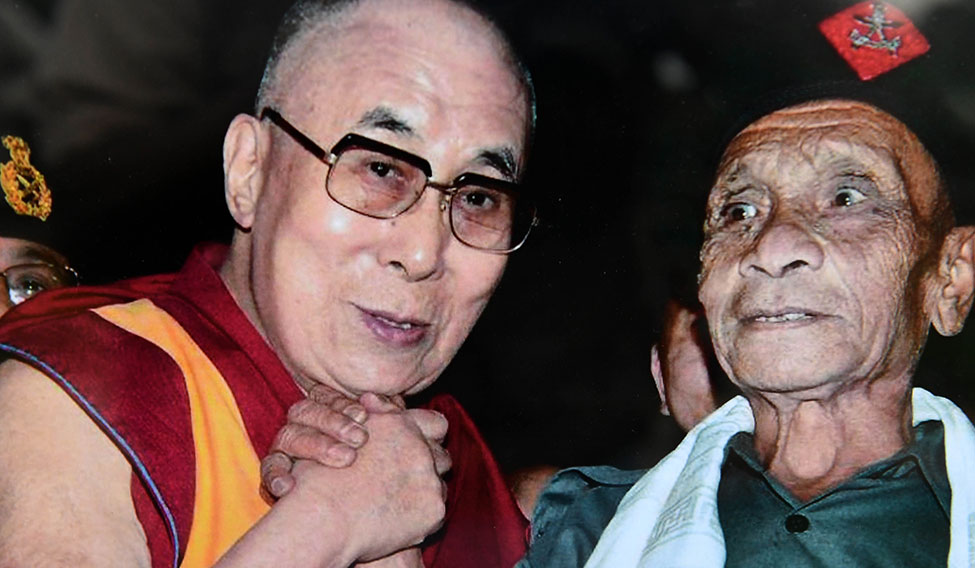Deepak Das is upset that he lost out on a big opportunity. His father, Naren Chandra Das, was one of the braveheart soldiers of the Assam Rifles who escorted the Dalai Lama to safety from the India-China border as he fled from Tibet in March 1959. Deepak didn’t know that. Fifteen years ago, he had appeared for a recruitment test for the Assam Rifles and failed to clear the fitness test. He now thinks he would have had a better chance, if he had known about his father’s rare distinction. “I came to know about it on April 3 this year when the Assam Rifles took him to Guwahati to meet the Dalai Lama,” says Deepak. “Had I known earlier, I would have told the recruiting officers.”
But the father doesn’t understand what the fuss is all about. “Why should I tell them about it?” he asks. “I had thought the world had forgotten about it. But, I was wrong. The director general of the Assam Rifles went through the records and traced me. He brought me to Guwahati during the felicitation of the Dalai Lama,” says Das, 76, who lives in Baliapara village in Sonitpur district of Assam.
Das was 14 when his father died and he had to provide for his family of 11 brothers and sisters. He worked as a farmhand for some time before joining the Assam Rifles and was good at boxing and football. He had completed three years in service, when on March 15, 1959, he got a call from the commandant’s office to be part of a secret assignment. “The most horrifying thing was that I was asked to travel 400km, from Tezpur in Assam to Tawang in Arunachal Pradesh, by foot. We didn’t have motorable roads back then,” says Das, sitting in the office of the Assam Rifles at Baliapara, where he is called these days to speak with the jawans and share his experiences.
“After ten days, I reached Tawang. I was posted at Suthamba alongwith ten other jawans,” recalls Das. “It was very cold and we were all shivering in sub-zero temperatures. We were told that we were going to do something important.” Four days later, just after sunset, Das saw an army of 2,000 Tibetans approaching the border through the jungle. “Our platoon was led by Subedar Saral Singh Thapa, who told us that the Tibetan religious leader, the Dalai Lama, was coming with his army and people.”
Das and five of his colleagues—mostly Gorkhas—approached the Dalai Lama’s army. He met a young and stout-looking Dalai Lama, who had a confident smile on his face. “He was so young and his face was red like an apple,” says Das. “He was riding a mule while his people were walking. They had walked for ten days to reach the border.” The men guarding him looked tense. When Das tried to get closer to the Dalai Lama, he was stopped by the armymen, who were carrying guns. “I wanted to help him get off the mule, but his army didn’t let me do it,” says Das. “Even subedar sir was not able to go near him.”

Das escorted the leader as he covered the last 20km to Tawang. The Dalai Lama was wearing a saffron robe, the kind he wears even today. He had shoes on his feet, but he was shivering because of the extreme cold. He was talking to his own people in his native language. When Das asked him a couple of questions in Hindi, he got no response from him. “He communicated with us through his armymen,” says Das.
Next day, the Dalai Lama was taken to the Tawang government guesthouse. Once a larger team of soldiers took charge, Das and the others were asked to return to the border post. Additional contingents were sent to assist them. “That night was terrifying. We were expecting an attack from China. The Dalai Lama was kept under tight security. His men were scared as they were put up in different camps. We were also very tense,” says Das.
Next day, the Dalai Lama was moved to Bombdila in Arunachal Pradesh and then to Assam and finally to Delhi. The jawans who escorted the leader were soon relieved of their border posting. Das joined the sports division of the Assam Rifles.
Three years later, China launched an attack from the very post the Dalai Lama entered India. Das’s colleagues from the secret assignment were sent to war. “Only three of them survived,” he says. Das retired as havildar in 1982.
On April 3 this year, Das greeted the Dalai Lama with a salute, like he had almost 60 years ago. “When I saluted the man last time, he ignored me. But this time, he returned my gesture,” says Das. “Not only that, he hugged me and I saw tears in his eyes. I broke down, too. I had never thought I would be able to meet him again.”
The spiritual leader tied a sacred thread (locally called thaga) around his neck. “He told me in English that because of people like me he is safe in India,” says Das. “I told him he has made me famous.”
“We are planning to host a felicitation for Das,” says Assam Rifles spokesperson Rahul Joshan. But the people of Baliapara don’t want to draw China’s attention towards them. “We live close to China and we want peace,” says Ankur Das, president of All Assam Students Union. “So, let us not turn Naren babu into a cult figure against China.”








